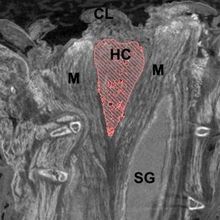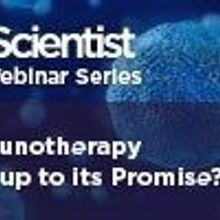Login
Subscribephysiology

Connecting the Complexities of Heart Failure and Aging
Deanna MacNeil, PhD | Feb 13, 2023 | 3 min read
Researchers learned how IGFBP7, a senescence signaling protein and biomarker, promotes cardiac remodeling and cellular aging.

Scientists Discover New “Superfast” Muscle Fibers in Mouse Limbs
Katherine Irving | Feb 9, 2023 | 4 min read
Fast twitch fibers like these could one day be used to treat diseases like Parkinson’s.

Metabolomic Links Between Environmental Exposures and Human Health
The Scientist’s Creative Services Team | 1 min read
Experts discuss how untargeted metabolomic studies connect environmental factors with human disease.

Daily Gene Expression Rhythms Vary with Sex and Age: Study
Alejandra Manjarrez, PhD | Feb 2, 2023 | 3 min read
By studying tissues from deceased people, a team found that women have more rhythmical gene expression and that this molecular rhythmicity decreases with age.

Scientists Use Centrifuge to Discover a Hormone
Katherine Irving | Jan 23, 2023 | 3 min read
A new method for isolating extracellular fluid aims to discover molecules with therapeutic potential that were previously obscured by highly abundant proteins.

Spatial Biology in Physiology and Pathology
The Scientist’s Creative Services Team | 1 min read
Elana Fertig and Sanjay Srivatsan discuss the importance of the spatial dimension for biological systems research.

Epigenetic Manipulations Can Accelerate or Reverse Aging in Mice
Alejandra Manjarrez, PhD | Jan 12, 2023 | 4 min read
Repairing damaged DNA appears to drive aging by causing the loss of epigenetic information, but restoring that information reverses such effects, a study finds.

Specialized Sperm Ribosomes Are Key to Male Fertility in Mice
Dan Robitzski | Dec 15, 2022 | 4 min read
A previously unknown kind of ribosome is responsible for folding sperm proteins, which decay before fertilization if prepared by other ribosomes.

Demystifying the Black Box
The Scientist’s Creative Services Team and Tecan | 1 min read
One sophisticated laboratory tool detects absorbance, fluorescence, FRET, luminescence, live cells, and more, facilitating a wide variety of experimental findings.

Snakes Have Clitorises After All, Study Finds
Natalia Mesa, PhD | Dec 13, 2022 | 4 min read
Researchers visualize the snake clitoris in detail for the first time, finding evidence that the organ may be evolutionarily important for snake sex.

Scientists ID Heart-Damaging SARS-CoV-2 Protein
Grace van Deelen | Nov 22, 2022 | 3 min read
In flies and mice, a viral protein increases the rate of energy use by heart cells. But it’s not yet clear if the finding applies to humans.

Technique Talk: Redefining Mouse Transgenesis with CRISPR-Cas Technology
The Scientist’s Creative Services Team | 1 min read
Learn how CRISPR-Cas technology has revolutionized the creation of transgenic mouse models.

The Smell of Food Affects Metabolism in Fasting Mice
Shafaq Zia | Nov 18, 2022 | 3 min read
The odor prompted the animals’ fat cells to release lipids into circulation.

Mice Fed a Highly Processed Diet Are More Susceptible to the Flu
Alejandra Manjarrez, PhD | Nov 18, 2022 | 3 min read
It’s not clear why grain-fed mice are better able to recover after infection, but a study’s findings suggest food type may skew the results of animal studies.

Defined Primary Cell Culture and Media
The Scientist Creative Services Team in collaboration with MilliporeSigma | 3 min read
A new partnership opens the door for a source of highly purified human primary cells and defined cell culture media.

Leprosy Bacterium Rejuvenates Armadillos’ Livers
Alejandra Manjarrez, PhD | Nov 15, 2022 | 4 min read
Mycobacterium leprae appeared to reprogram the animals’ livers to a state partially resembling early development, resulting in healthy organ growth.

Infographic: How Immunology Can Influence Pregnancy Outcomes
Tobias R. Kollmann, Arnaud Marchant, and Sing Sing Way | Nov 14, 2022 | 3 min read
Pregnancy-induced changes in the immune system are key to a successful birth. Understanding those changes could allow researchers to protect both mother and child.

Is Immunotherapy Living Up to Its Promise?
The Scientist’s Creative Services Team | 1 min read
The Scientist is bringing together a panel of experts to weigh in on the progress that immunotherapy has made.

Modulating Immunity to Improve Pregnancy Outcomes
Tobias R. Kollmann, Arnaud Marchant, and Sing Sing Way | Nov 14, 2022 | 10+ min read
Aberrant immune activation, the main cause of prematurity and stillbirths, could be preventable through interventions such as maternal vaccination.

Caught on Camera
The Scientist Staff | Nov 14, 2022 | 3 min read
See some of the coolest images recently featured by The Scientist